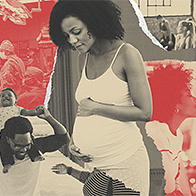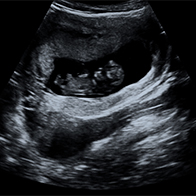We Need to Talk More About Stillbirths

The first 38 weeks of Lindsey Wimmer's first pregnancy were "textbook," healthy and uneventful. Like most expecting parents, and as a nurse practitioner certified in perinatal loss care, she had concerns—especially about premature labor. But, for the most part, the eager anticipation of meeting her newborn eclipsed any trepidation.
"When I was 38 weeks along, I had a normal visit with my OB, and all appeared to be well," Wimmer recalled. "Two days later, my husband and I were laughing at my belly before we went to bed because the baby was moving so much and so crazily that my belly was morphing and moving around in a way we'd never seen before. We went to bed not realizing that those movements were actually a cry for help from our baby."
Not long after, she awoke in the middle of the night with a "horrible sense of doom." Wimmer realized she hadn't felt the baby move since she'd awakened, a rarity at this point in pregnancy.
Although something felt off, Wimmer was worried about calling her OB because she lacked the symptoms she'd been told to watch for: fever, pain or bleeding. Eventually, she called and scheduled an appointment for first thing in the morning. Doctors performed an ultrasound after multiple unsuccessful attempts to find the baby's heartbeat.
'My doctor explained that I would have to labor and deliver this baby just like we had been planning if the baby was still alive.'
Wimmer was briefly excited because she hadn't seen the baby since the 20-week ultrasound. "Unfortunately, my excitement was quickly shattered when the OB told us, 'This is your baby's heart. And it is no longer beating.' It took a while for me to realize what that meant.
"After giving us a few minutes alone, my doctor explained that I would have to labor and deliver this baby just like we had been planning if the baby was still alive. It felt like I was being punished for not being able to keep my baby alive," Wimmer said.
Like most new moms, she was already nervous about labor and delivery. "But the thought of enduring that pain when we wouldn't get to go home with a baby was more than I could comprehend. The next day, our son, Garrett Jamison Wimmer, was born in complete silence."
Doctors determined Garrett's cause of death was umbilical cord compression—the cord had knotted and wrapped around his neck and body six times.
Garrett was one of about 24,000 stillborn babies delivered in the United States every year.
The stigma of stillbirth
"A stillbirth is when a baby dies in the womb (uterus) after 20 weeks of pregnancy. Most stillbirths happen before a person goes into labor. And stillbirths are not uncommon—they happen to 1 in 160 pregnancies every year in the U.S. (about 24,000 a year)," said Kate White, M.D., an associate professor of obstetrics and gynecology at the Boston University School of Medicine and Vice-Chair of Academics in the OB-GYN department at Boston Medical Center.
Worldwide, stillbirths are far more prevalent, at 13.9 births per 1,000 in 2019, according to UNICEF. The rate is substantially higher in six countries: India, Pakistan, Nigeria, the Democratic Republic of Congo, China and Ethiopia. Together, these nations account for half of stillborn babies and 44 percent of global live births, per UNICEF.
"Much is discussed with pregnant women regarding the risks of cot death [SIDS], but in comparison, stillbirths are 10 times more common and have far fewer discussions," said Odette Abououf, R.M. "The lack of awareness comes partly because of the sensitive nature of the topic, but also because it's an area that is very complex with a great need for more research."
The stigma surrounding pregnancy loss, in general, also contributes to the relative silence, explained Kiarra King, M.D., F.A.C.O.G., an OB-GYN.
"Many women grieve these significant losses while also grappling with feelings of failure, shame and guilt. Some may primarily internalize the process, which can lead to isolation," King said. "Ultimately, someone who has gone through a stillbirth may find it challenging to find someone who has a similar story if the stories aren't there to be found. However, I do believe that is changing and that many have found healing in connecting with women with shared experiences."
"I often feel like a 'grim reaper' when I'm around pregnant people. I don't want to ruin a beautiful time for them, but I also feel like I need to tell them about how they can reduce their risks of what happened to us," said Wimmer, who is also the founder and executive director of Star Legacy Foundation, a nonprofit organization dedicated to reducing pregnancy loss and neonatal death.
"Unfortunately," Wimmer added, "the social narrative around pregnancy is that it is completely happy and easy. But that is not the case for thousands and thousands of families every year."
What causes stillbirth?
One of the most significant hurdles in stillbirth prevention is determining why they occur.
"About one-third of the time, doctors can't find a reason for a stillbirth. For the stillbirths we can explain, the reasons fall into four categories," said White, author of "Your Guide to Miscarriage and Pregnancy Loss."
These categories are:
- Placenta and Umbilical Cord Problems: "The placenta and umbilical cord give fluid, oxygen and nutrients from the mother to the baby and transfer waste from the baby to the mother. Problems with either the cord or the placenta threaten to starve or suffocate the baby," said White. "Two such problems are when the placenta separates from the wall of the uterus before birth (placental abruption) and umbilical cord compression, which pinches off the flow of blood and oxygen to the baby (most often caused by a knot in the cord)."
- Medical Conditions and Pregnancy Complications: "These include poor prenatal care, being malnourished, having a pre-pregnancy health condition (such as hypertension, diabetes, lupus, thyroid disorders, or thrombophilia, which make blood clots more likely)," White said. "Conditions that happen in the pregnancy that are associated with stillbirth include being pregnant for longer than 41 weeks; preeclampsia; intrahepatic cholestasis of pregnancy (ICP) or obstetric cholestasis, a liver disorder that causes severe itching; and trauma or injuries, such as from being in a car accident."
- Infections: "If you get a bacterial or viral infection during pregnancy, it can infect the baby and potentially cause a pregnancy loss," White warned. Such infections include cytomegalovirus (CMV), parvovirus, genital infections like herpes or syphilis, urinary tract infections, listeriosis and toxoplasmosis.
- Fetal Conditions: "Congenital disabilities and genetic conditions cause about 25 percent of all stillbirths. Stillbirth can also happen in pregnancies experiencing fetal growth restriction—also called intrauterine growth restriction (IUGR)—where the baby is not growing like it should be," White said.
Risk factors
While experts stress stillbirths are not a parent's fault, certain factors can increase the risk, including underlying medical conditions.
Some risk factors include smoking or secondhand smoke exposure, chronic exposure to air pollution, alcohol or drug use during pregnancy, preexisting diabetes, hypertension, obesity, multiple gestations, being under age 20 or over 35, first pregnancy, gestational diabetes and having an AB blood type. A baby who is small for their gestational age may also be more vulnerable.
Previous pregnancy conditions could impact a current pregnancy as well, White said. These include preterm birth, preeclampsia, fetal growth restriction (IUGR) and previous miscarriage or stillbirth.
"Some of these risk factors are modifiable, such as substance use, while others are not," King said. "Additionally, during the pregnancy of a patient with risk factors such as diabetes or hypertension, the goal is to adequately control those diseases to further minimize risks. However, that doesn't guarantee that their risk is eliminated."
The impact of socioeconomic disparities
Race/ethnicity and regional and socioeconomic disparities within health care also contribute. In the U.S., Black people are more than twice as likely to experience a stillbirth as other groups, except American Indian/Alaskan Native people, according to the Centers for Disease Control and Prevention (CDC).
Meanwhile, MBRRACE-UK and another review published in The Lancet found that about 25 percent of stillbirths in the United Kingdom result from socioeconomic inequalities. According to the reports, Black women are also four times as likely to die in childbirth and Asian women are twice as likely to die in childbirth compared to other groups.
"Among women of color, stillbirths were most likely related to infection, preterm labor and hypertensive disorders," said Kecia Gaither, M.D., a double board-certified physician in OB-GYN and Maternal-Fetal Medicine. Research indicates certain diseases linked to an increased susceptibility to stillbirths and maternal mortality, including heart disease, epilepsy and stroke, can also be linked to socioeconomic status.
Education, racial bias in the medical field and the general effects of socioeconomic inequality also play a role.
"The March of Dimes has a nice overview—briefly, we think this is due to disparities in access to prenatal care, unconscious (or conscious) bias from providers about not taking the concerns of pregnant people of color seriously, and the chronic stress on people's bodies due to living in a racist society," White said.
Abououf noted that reducing stillbirths starts with the government acknowledging the inequalities affecting many women. "These disparities include poor housing, poor diet, social isolation, limited health care, access to health care, low income, and unemployment of Black and ethnic minority women."
Can stillbirth be prevented?
Other than addressing socioeconomic factors and healthcare deficiencies, research indicates few evidence-based ways to prevent stillbirth.
"In low-income nations, much of the prevention efforts are focused on access to skilled birth attendants, mosquito netting, and access to antibiotics and other medicines. In high-income settings, stillbirth prevention requires identifying the vulnerable baby," Wimmer said. "Our current medical systems have developed to identify babies who are at risk because the mother has health concerns. The bigger challenge is finding a distressed baby in a healthy mother that is not exhibiting any symptoms," Wimmer added.
Abououf and White said expecting parents can also take certain steps (if available) to increase the likelihood of a healthy pregnancy. These include attending pre-conception and prenatal care appointments, managing illnesses, maintaining a healthy lifestyle and diet, and taking measures to prevent food poisoning and viruses. Parents are also advised to alert their midwife or maternity team of any concerns, such as bleeding, cramping, tummy itching or pain, or changes in the baby's movement patterns.
Experts also advise pregnant people to sleep on their side, not their back, after 28 weeks. A pregnancy pillow can help with this.
"Research suggests that women who sleep on their backs after 28 weeks gestation have double the risks of stillbirth. This could be that the baby's oxygen supply is less efficient when sleeping on your back," Abououf said.
"I wish I had known that even in the 21st century, healthy babies in healthy moms and healthy pregnancies can still have tragic endings," Wimmer said. "I encourage all pregnant families to learn about their risk factors and how to reduce them, and to get to know their baby—and report any change immediately."



















